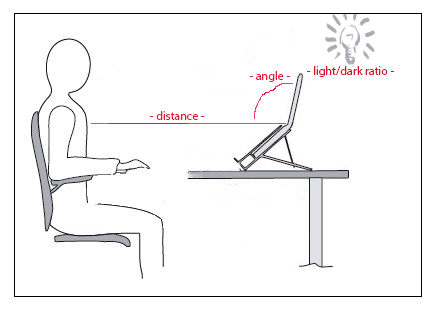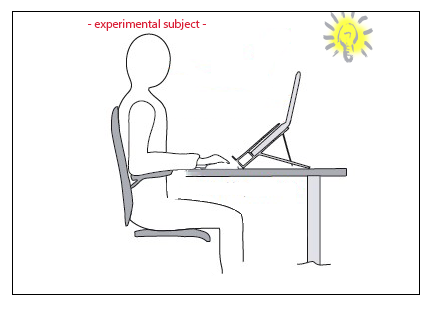Measurement plan
Experiment 1
List of equipment:
- 1. Laptop with Noldus software ‘FaceReader 7.0’
- 2. Webcam
- 3. Lightsource
- 4. Chair
- 5. Table
Figure 11: Set-up experiment 1
Experiment 1.1: varying distance, constant angle, constant light/dark ratio
Steps to take:
- 1. Turn on laptop and start ‘FaceReader 7.0’
- 2. Start ‘new project’
- 3. Select ‘new participant’
- 4. Select the connected camera
- 5. Take place in front of the laptop, with the face pointing directly towards the webcam
- 6. Start an analysis
- 7. If the software recognizes the face, increase the distance between participant and webcam
- 8. Repeat till the maximum allowable distance is reached
- 9. Write down this distance
Experiment 1.2: constant distance, varying angle, constant light/dark ratio
Steps to take:
- 1. Turn on laptop and start ‘FaceReader 7.0’
- 2. Start ‘new project’
- 3. Select ‘new participant’
- 4. Select the connected camera
- 5. Take place in front of the laptop, with the face pointing directly towards the webcam
- 6. Start an analysis
- 7. Let the participant turn her/his head slowly to the right, until the face cannot be detected anymore
- 8. Write down this angle
- 9. Repeat this also for the directions, left, up and down
- 10. Increase the distance between participant and repeat until the face cannot be detected anymore
Experiment 1.3: constant distance, constant angle, varying light/dark ratio
Steps to take:
- 1. Turn on laptop and start ‘FaceReader 7.0’
- 2. Start ‘new project’
- 3. Select ‘new participant’
- 4. Select the connected camera
- 5. Take place in front of the laptop, with the face pointing directly towards the webcam
- 6. Start an analysis
- 7. Make the room as dark as possible and slowly turn on the lights
- 8. Write down when the face is first detected and at which point (if necessary) it cannot be detected anymore
- 9. Repeat for turning the lights of
Experiment 2
List of equipment:
- 1. Laptop with recoding software
- 2. Webcam
- 3. Lightsource
- 4. Chair
- 5. Table
- 6. Movie fragments (see section below)
Figure 12: Set-up experiment 2
Experiment 2.1: Varying experimental subject with constant circumstances
Steps to take:
- 1. Turn on laptop and start ‘FaceReader 7.0’
- 2. Start recording software
- 3. Place the experimental subject in front of the laptop, with the face pointing directly towards the webcam
- 4. Start the first fragment with emotion ‘Happy’
- 5. After two minutes, stop the fragment
- 6. Start an analysis
- 7. Ask the participant how he felt during the experiment and write it down
- 8. Repeat this for the fragments with emotions ‘Angry’, ‘Sad’, ‘Fear’, ‘Disgusted’ and ‘Surprised’.
Selected fragments for experiment 2
Researchers interested in emotion have long struggled with the problem on how to elicit emotional responses in the laboratory. In the article of James J. Gross and Robert W. Levenson[1], five years of work to develop a set of films that reliably elicit each of eight emotional states is summarized. These eight emotional states are amusement, anger, contentment, disgust, fear, neutral, surprise and sadness
We will only use the movies for the 6 basic emotions, this is based on the possibilities of the Noldus software, and on Eckman’s faces.[2] These emotions are happiness, anger, disgust, fear, sadness and surprise. We also take into consideration the movies of neutral, because the Noldus software can also measure this and we want to test it.
Movies
Movies were selected that are approximately 2 minutes of duration, because this is the maximum duration that the recieved software can analyse.
Neutral:
Abstract shapes: https://www.youtube.com/watch?v=MHNlkCWjznM
Amusement/ happiness:
Ronald Goedemondt: https://www.youtube.com/watch?v=TSyofAODLxQ
Anger:
Protest against police: https://www.youtube.com/watch?v=JwiFgzcz0GE
Bullying: https://www.youtube.com/watch?v=8A93UJdENbY
Fear:
The Shining: hallway scene https://www.youtube.com/watch?v=79p57JJrMwo
Sudden shock: https://www.youtube.com/watch?v=zwdpTdmGy_M
Disgust:
Arm amputation: https://www.youtube.com/watch?v=U1VaYbrgW8s
Sadness:
Father dies: https://www.youtube.com/watch?v=FAhrqKqK_cA
Surprise:
Mind reading: https://www.youtube.com/watch?v=YzTdJkQRqG8
Discussion of movies
What is important to take into consideration is that the tests can be shocking, so participants have to be informed very well on forehand, and they have to agree to the research after being well informed.
For amusement the movies were not very up to date anymore, so similar movie is used.
For anger, the movies were not traceable anymore therefore a movie of protests against police armies was chosen, just as the title: “Cry Freedom (CRY)- police abuse protesters” suggests, and a movie about high school teasing. These movies can be a bit shocking.
Also for fear, another movie was added that is not in the research, so there are two movies for fear that will be shown shown. For surprise it was very hard to find an appropriate movie. The movies from the article were not traceable anymore and it is not sure whether they are significantly surprising enough. So the results of the Noldus software of surprise might not be reliable, it might be mixed up with happiness.
References
- ↑ Gross, J.J and Levenson, R.W. (1995), Emotion Elicitation Using Films, Retrieved from http://ist-socrates.berkeley.edu/~ucbpl/docs/48-Emotion%20Elicitation95.pdf
- ↑ O'Carroll, Eoin. How many basic emotions do you have? It's written on your face, say scientists., The Christian Science Monitor [Boston, Mass] 07 Apr 2014: 21.

